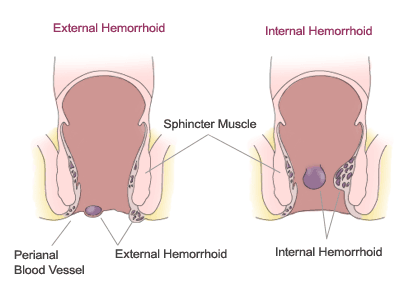Hemorrhoids
Hemorrhoids are very common. They are nothing more than enlarged veins. When they occur in the lower legs, they are called varicose veins. When they occur in the rectum, they are called hemorrhoids or “piles.” Swelling can be caused by straining to move your bowels, sitting too long on the toilet, or from other factors such as pregnancy, obesity or liver disease.
 The most common symptom of internal hemorrhoids is bright red blood covering the stool, on the toilet paper or in the toilet bowl. Bleeding occurs when the swollen veins are scratched or broken by straining or rubbing. This can be aggravated by medicines that thin the blood. An internal hemorrhoid may protrude through the anus, becoming irritated and painful. This is known as a protruding or prolapsed hemorrhoid.
The most common symptom of internal hemorrhoids is bright red blood covering the stool, on the toilet paper or in the toilet bowl. Bleeding occurs when the swollen veins are scratched or broken by straining or rubbing. This can be aggravated by medicines that thin the blood. An internal hemorrhoid may protrude through the anus, becoming irritated and painful. This is known as a protruding or prolapsed hemorrhoid.
Symptoms of external hemorrhoids may include painful swelling or a hard lump around the anus that results when a blood clot forms. This condition is known as a thrombosed external hemorrhoid.
Hemorrhoid problems are very common in men and women. About half of all people have noticeable hemorrhoids by age 50. Many people have occasional bleeding from hemorrhoids, but most often the bleeding is self-limited. Women may begin to have problems during pregnancy. The pressure of the fetus in the abdomen, along with hormonal changes, cause hemorrhoidal veins to enlarge. These veins also are placed under severe pressure during the birth of the baby.
A diet high in fiber may help by softening the stool, making it easier to empty the bowels and lessen pressure on the veins. A high fiber diet includes fresh fruits, leafy vegetables, and whole-grain breads and cereals (especially bran). Fiber supplements and stool softeners may be helpful as well as drinking six to eight glasses of fluid (not alcohol) each day.
Good hygiene is also important. Bathe the anus gently after each bowel movement using soft, moist toilet paper (or a commercial moist pad). Avoid a lot of wiping. If necessary, you can even use a bath or shower as an alternative to wiping. After bathing, dry the anus gently with a soft cloth or towel. Ice can be applied to external hemorrhoids when they are thrombosed and painful and may provide some relief.
To protect against irritation, cleanse the anus gently and apply zinc oxide paste (or powder) to the area. Medicated suppositories or creams are available at the drug store. Any of these home treatments may relieve the symptoms and no additional treatment may be required.
When dietary modifications and medical treatments are not enough, a number of methods can be used to remove or reduce the number of hemorrhoids:
- Infrared coagulation: Involves the application of infrared light to the base of the hemorrhoid, which clots the hemorrhoid. There are usually three different areas inside the rectum where hemorrhoids occur, and they are referred to as complexes. One area, or complex, is treated at each visit. Occasionally a little bleeding will occur between the fourth day and the tenth day after treatment.
- Band ligation: A rubber band is put around the base of the hemorrhoid. The band cuts off circulation, and the hemorrhoid withers away within a few days.
- Sclerotherapy: A chemical is injected around the vein to shrink the hemorrhoid.
- Surgical treatment: Cutting out the hemorrhoids (hemorrhoidectomy) is sometimes recommended, but involves a painful recovery.
Prevention
- Pass your bowel movements as soon as possible after the urge occurs.
- Avoid straining.
- Be active. Move around, walk and exercise to help move the stools through your body.
- Stay regular by eating enough fiber and drinking enough fluid. Most Americans only take in 13 grams of fiber in their daily diet, half of what is recommended. Adding fiber to your diet helps to produce stools that are softer and easier to pass.
